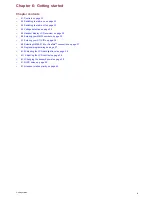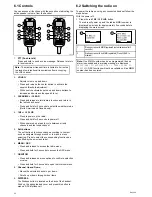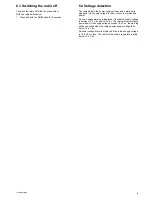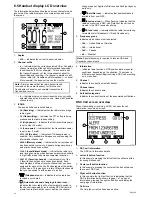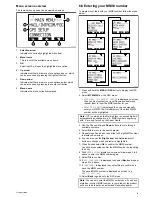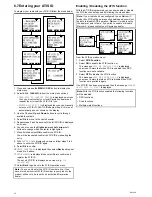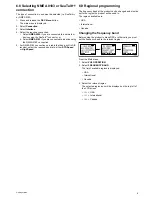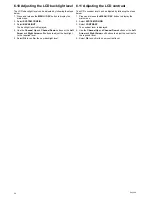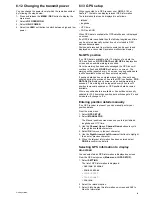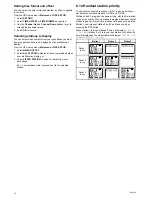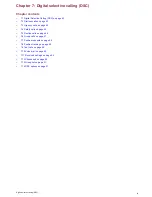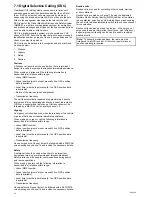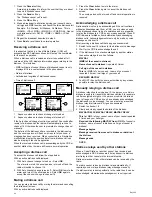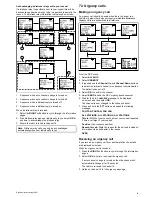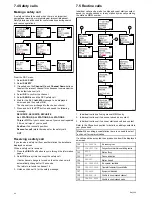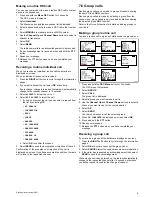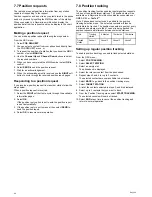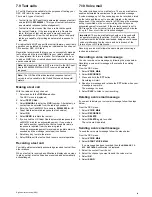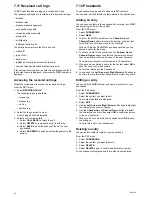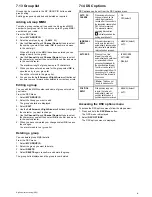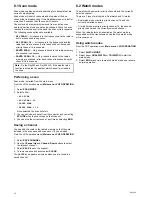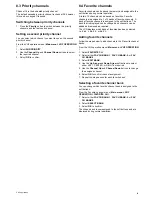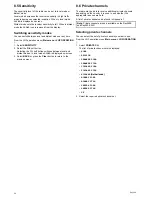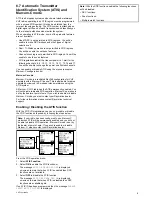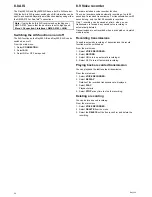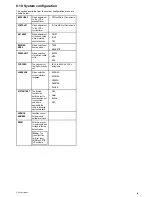
1. Press the
Cancel
soft key.
A warning is displayed to inform the user that they are about
to send a ‘Distress cancel call’.
2. Press the
Send
soft key.
The ‘Distress cancel call’ is sent.
3. Press the
OK
soft key.
4. Make a broadcast to all stations giving your vessel’s name,
call sign and MMSI number and cancel the false distress alert
Example: “All, Stations, All Stations, All Stations. This is
<NAME>, <CALL SIGN>, <MMSI ID>, <POSITION>. Cancel
my distress alert of <DATE>, <TIME>, <NAME>, <CALL
SIGN>”.
5. Repeat the broadcast described in step 4.
6. Press
End
to revert back to normal operation.
Receiving a distress call
It is expected that only a Coast Radio Station (CRS) will
acknowledge DSC distress calls and will act as the coordinator
for the rescue operation.
When a distress call is received an alarm is sounded at full
volume and the LCD displays information pages relating to the
distress. This includes:
• MMSI or Name of vessel (Name of distressed vessel is only
displayed if it is a contact saved in the phonebook).
• Nature of distress.
• Latitude and longitude of distressed vessel.
• Time of distress call.
O
K
PAUSE
P
1/4
HI
DISTRESS] 00'01
ALERT
FROM: 1234 56789
FIRE
O
K
PAUSE
P
2/4
HI
DISTRESS] 00'02
ALERT
LAT: 12
O
3 4 .5 6 7 8 N
LON: 123
O
45.6789W
O
K
PAUSE
P
3/4
HI
DISTRESS] 00'03
ALERT
UTC: 12:34
O
K
PAUSE
P
4/4
HI
DISTRESS] 00'11
ALERT
AUTO TUNING
IS OPERATE D
O
K
PAUSE
P
4/4
HI
DISTRESS] 00'11
ALERT
CH REQ:001 6
PRESS
[
OK
]
D12817-1
1
2
1.
Sequence when auto channel change is turned on.
2.
Sequence when auto channel change is turned off.
If the Auto channel change function is enabled 10 seconds after
receipt of a distress call the radio will automatically re-tune to
channel 16. Otherwise the user is prompted to change channel
manually.
The details of the distress call are recorded in the distress log
and the envelope icon will flash on-screen to let you know a
message has been received. When connected to a Raymarine
multifunction display the position data from a distress call can
also be display in the chart application.
When the received distress call is acknowledged by the CRS or
another station then the radio will resume normal operation.
Accepting a distress call
To accept the distress call follow the steps below.
With an active distress call displayed.
1. With Auto channel change turned on – Select
OK
.
The alarm is muted, the envelope icon is turned off and the
radio will switch to channel 16.
2. With Auto channel change turned off – Select
OK
to mute the
alarm and turn off the envelope icon. Select
OK
again to
accept the channel change to channel 16.
Muting a distress call
You can ignore a distress call by muting the alarm and cancelling
the distress call screen.
With an active distress call displayed.
1. Press the
Clear
button to mute the alarm.
2. Press the
Clear
button again to cancel the distress call
screen.
The envelope icon will be turned off and normal operation is
resumed.
Acknowledging a distress call
Distress calls must only be acknowledged if the call continues
without acknowledgement from a CRS, you are close enough
to the distressed vessel to be of assistance and are prepared
to relay the distress to a CRS by any means possible. Class D
DSC radios are forbidden from automatically acknowledging
distress calls. Acknowledgement must only be made by voice
message on channel 16.
After receiving a distress call that has gone unanswered:
1. Switch to channel 16 to listen for the distress voice message.
2. Wait for the CRS to acknowledge the call.
3. If the distress call is not acknowledged by another station
then acknowledge the call as follows:
MAYDAY
(MMSI of the vessel in distress)
Name of vessel in distress
<repeated 3 times>
Call sign of the vessel in distress
This is
<MMSI of your vessel>, <name of your vessel
repeated 3 times> <call sign of your vessel>
RECEIVED MAYDAY
4. You MUST then notify the shore authorities by any means
possible to relay the distress call.
Manually relaying a distress call
A distress relay should only be sent if: the person or vehicle in
distress is unable to transmit the distress call itself, for example
red flares sighted at night or the person or vehicle in distress
is out of range of a CRS and you have already acknowledged
the distress by voice message. You can also relay a received
distress relay alert manually if it goes unanswered.
1. Switch to channel 16
2. Slowly and clearly speak the details of the distress:
MAYDAY RELAY, MAYDAY RELAY, MAYDAY RELAY
This is
<MMSI of your vessel, name of your vessel repeated
3 times and your call sign>
Received the following MAYDAY from
<MMSI of vessel in
distress, name of vessel in distress, call sign of vessel in
distress>
Message begins
Message received from vessel in distress or details of
the distress
Message ends
OVER
Distress relays sent by other stations
When a Coast Station or another vessel, has received, and
acknowledged a DSC distress alert it may transmit a distress
alert relay to other vessels in the immediate area.
Distress relays sent from other stations can be received by the
radio.
The radio cannot re-send a distress relay automatically. If
required you can relay a distress relay message manually.
If a distress relay is sent specifically to the radio then it can be
acknowledged, otherwise acknowledgement is not required.
44
Ray260
Summary of Contents for Ray260
Page 2: ......
Page 4: ......
Page 18: ...18 Ray260 ...
Page 30: ...30 Ray260 ...
Page 52: ...52 Ray260 ...
Page 60: ...60 Ray260 ...
Page 64: ...64 Ray260 ...
Page 68: ...68 Ray260 ...
Page 72: ...72 Ray260 ...
Page 80: ...80 Ray260 ...
Page 92: ...92 Ray260 ...
Page 93: ......
Page 94: ...www raymarine com ...


